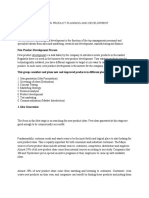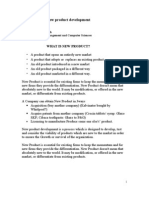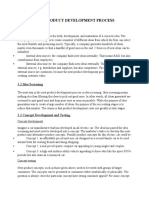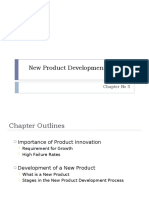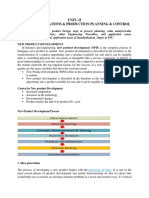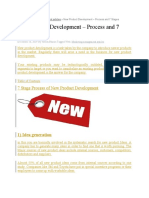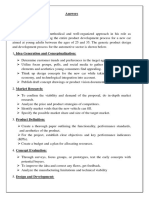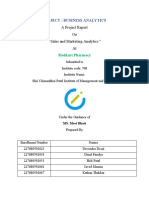Document 7
Document 7
Uploaded by
Mohamed Bashar0 ratings0% found this document useful (0 votes)
22 views4 pagesThe document outlines objectives and issues for the first two periods of operation. The first period objectives are to provide low-cost, high-quality service and jobs, reach the break-even point, gain a good reputation, and increase customer awareness. The second period aims to expand the business and gain more market confidence. The main issues are people's confidence in the service and competing in the fast food market.
The document also discusses product development strategy and its seven stages: idea development, editing and selection, prototype creation, analysis, product creation, market testing, and commercialization. Having a strong product development strategy supports a business' ability to create profitable products and modify them to remain competitive.
Original Description:
Copyright
© © All Rights Reserved
Available Formats
DOCX, PDF, TXT or read online from Scribd
Share this document
Did you find this document useful?
Is this content inappropriate?
Report this DocumentThe document outlines objectives and issues for the first two periods of operation. The first period objectives are to provide low-cost, high-quality service and jobs, reach the break-even point, gain a good reputation, and increase customer awareness. The second period aims to expand the business and gain more market confidence. The main issues are people's confidence in the service and competing in the fast food market.
The document also discusses product development strategy and its seven stages: idea development, editing and selection, prototype creation, analysis, product creation, market testing, and commercialization. Having a strong product development strategy supports a business' ability to create profitable products and modify them to remain competitive.
Copyright:
© All Rights Reserved
Available Formats
Download as DOCX, PDF, TXT or read online from Scribd
Download as docx, pdf, or txt
0 ratings0% found this document useful (0 votes)
22 views4 pagesDocument 7
Document 7
Uploaded by
Mohamed BasharThe document outlines objectives and issues for the first two periods of operation. The first period objectives are to provide low-cost, high-quality service and jobs, reach the break-even point, gain a good reputation, and increase customer awareness. The second period aims to expand the business and gain more market confidence. The main issues are people's confidence in the service and competing in the fast food market.
The document also discusses product development strategy and its seven stages: idea development, editing and selection, prototype creation, analysis, product creation, market testing, and commercialization. Having a strong product development strategy supports a business' ability to create profitable products and modify them to remain competitive.
Copyright:
© All Rights Reserved
Available Formats
Download as DOCX, PDF, TXT or read online from Scribd
Download as docx, pdf, or txt
You are on page 1of 4
Objectives and Issues:
We have set attainable objectives for the first and second periods of
operation
First-period Objectives:
By the end of the first period of operating, by xxxxxxxx will achieve a set
of
objectives:
Within achieving the main goal is to provide service at a low price and
excellent quality and to provide job opportunities for a large segment
of society, reach the break-even point and to gain a good reputation
during our first steps and to increase the awareness of our customers
for our service also to deliver our value to the mentioned market
segment as much as possible.
In addition to that, business deals with other businesses will be helpful
during our first year of operation in this field, which guarantees mutual
Benefits.
second periods of operation:
During the second period of operation, we aim to expand and gain
more confidence in the market
Issues
The main Issues revolves around people's confidence in the service and
the way to fight in the fast food market
–Product Development Strategy:
Product development includes all aspects of producing
innovation, from thinking of a concept to delivering the
product to customers. When modifying an existing product to
create new interest, these stages verify the potential success
of the modifications at generating business. The seven stages
of product development are:
1. Idea development: Idea development involves
brainstorming for new products and ways to make
existing products more relevant.
2. Editing and selection: During the selection process, the
product development team determines which ideas have
the most potential to do well in the market.
3. Prototype creation: Once an idea has been selected, the
company must create a prototype or draft version of its
proposed product. This prototype can be used to
determine if the product functions as intended and
appeals to your target audience.
4. Analysis: At the analysis stage of product development,
the company studies market research and evaluates the
possible problems with the product.
5. Product creation: After incorporating notes from the
analysis into the prototype, the finished product can be
created.
6. Market testing: Before releasing the product to a wider
audience, products are often released to a smaller
market or focus group. The market testing phase
includes evaluating customer feedback and the
effectiveness of the product's marketing.
7. Commercialization: The final stage of product
development occurs when adjustments are made based
on market testing and the product is released to the full
market.
Benefits of product development strategy:
Having a strong product development strategy can support
your business' ability to turn an idea into a profitable product
and then modify it to remain competitive within the market.
Your product development strategy can reveal areas for
improvement as well as which methods are most successful.
To receive the most benefits from your product development
strategy, consider how various techniques would work for
each step and make adjustments based on your past
experiences.
You might also like
- The New Product Development ProcessDocument4 pagesThe New Product Development ProcessDileepNo ratings yet
- Nestle Case Analysis FinalDocument6 pagesNestle Case Analysis FinalSandeep Kumar100% (1)
- New Product Options and DevelopmentDocument6 pagesNew Product Options and Developmentkavya reddyNo ratings yet
- Product Planning and DevelopmentDocument5 pagesProduct Planning and Developmentbabunaidu2006No ratings yet
- New Product Developmen1Document5 pagesNew Product Developmen1srvjeetNo ratings yet
- Discovering New Product Development StrategyDocument7 pagesDiscovering New Product Development StrategyLi An BautistaNo ratings yet
- Chap 1 - Product DecisionsDocument39 pagesChap 1 - Product Decisions2852 Takmoge AdityaNo ratings yet
- Product Planning Process To Launch A New ProductDocument5 pagesProduct Planning Process To Launch A New ProductNaureen AyubNo ratings yet
- CH 04 Product & Service ConceptDocument8 pagesCH 04 Product & Service ConceptWondmageneUrgessaNo ratings yet
- Pom Unit-2Document34 pagesPom Unit-2bhadrichandu961No ratings yet
- Product and Brand Management PSDA-1: Idea Generation: The Systematic Search For New Product IdeaDocument5 pagesProduct and Brand Management PSDA-1: Idea Generation: The Systematic Search For New Product IdeaAmartya SrivastavaNo ratings yet
- Module 5 TSH NotesDocument13 pagesModule 5 TSH NotesHarishNo ratings yet
- New Product Development - SaiDocument14 pagesNew Product Development - Saisainath89100% (1)
- Entrepreneurship CH 4Document19 pagesEntrepreneurship CH 4AYELENo ratings yet
- New Product Development and Challenges Report Final DraftDocument21 pagesNew Product Development and Challenges Report Final DraftUzma SalmanNo ratings yet
- FinalpdndDocument32 pagesFinalpdndPulkit Garg100% (1)
- The New Product Development ProcessDocument5 pagesThe New Product Development Processkhalid100% (1)
- Marketing ManagementDocument15 pagesMarketing Managementyatinthukral758545No ratings yet
- Product DevelopmentDocument41 pagesProduct DevelopmentJohn Rey SR SoveranoNo ratings yet
- New Product Development ProcessDocument3 pagesNew Product Development ProcessSrishti jNo ratings yet
- Chapter 4: Product/Service DevelopmentDocument11 pagesChapter 4: Product/Service Developmentfeyeko aberaNo ratings yet
- MGT303Document18 pagesMGT303KELVIN KWESI HOWARDNo ratings yet
- Enter ch-4 PPT NewDocument33 pagesEnter ch-4 PPT NewYemane Admasu GebresilassieNo ratings yet
- New Product DevelopmentDocument4 pagesNew Product DevelopmentThe Oxford College of Engineering100% (1)
- Principles of MarketingDocument41 pagesPrinciples of Marketingknbvd2489No ratings yet
- Marketing Managemnt Assignment: Ans 1) As A Newly Appointed Product Manager of Balaji Wafers, If I Was Asked To Develop ADocument9 pagesMarketing Managemnt Assignment: Ans 1) As A Newly Appointed Product Manager of Balaji Wafers, If I Was Asked To Develop Abikahiw507No ratings yet
- New Product Development Process: Chapter No 5Document12 pagesNew Product Development Process: Chapter No 5PhD ScholarNo ratings yet
- Final Facial Spray ProjectDocument35 pagesFinal Facial Spray ProjectPraneit KhotNo ratings yet
- New Product Development Process Additional SlidesDocument13 pagesNew Product Development Process Additional Slideschadrick.knoxleyNo ratings yet
- Innovation Management Iii Bcom (Unit Iv)Document11 pagesInnovation Management Iii Bcom (Unit Iv)Commerce DepartmentNo ratings yet
- POM Unit IIDocument13 pagesPOM Unit IIShiVâ SãiNo ratings yet
- Mihret New - Product - Development - StagesDocument23 pagesMihret New - Product - Development - StagesDuke GlobalNo ratings yet
- Tatanexon New Product DevelopmentDocument29 pagesTatanexon New Product DevelopmentGAURAV SHARMA100% (1)
- New Product Development Process - PPTX Version 1Document11 pagesNew Product Development Process - PPTX Version 1Rainier Dulay100% (2)
- New Product DevelopmentDocument3 pagesNew Product DevelopmenthaiquanngNo ratings yet
- Unit IvDocument13 pagesUnit IvCommerce DepartmentNo ratings yet
- L 4-TQMDocument2 pagesL 4-TQMJan Drew OlivaNo ratings yet
- Phases of Product PlanningDocument5 pagesPhases of Product PlanningAnonymous 2ZtRZZNo ratings yet
- PRODUCTDocument6 pagesPRODUCTAbhishek SinhaNo ratings yet
- Product Development StrategyDocument82 pagesProduct Development StrategyTameneNo ratings yet
- New Product Development - Process and 7 StagesDocument8 pagesNew Product Development - Process and 7 StageskashemNo ratings yet
- New Product Development ProcessDocument17 pagesNew Product Development ProcessIshaan GoyalNo ratings yet
- Universiy of Cebu Lapu-Lapu and Mandaue Campus College of Business AdministrationDocument3 pagesUniversiy of Cebu Lapu-Lapu and Mandaue Campus College of Business AdministrationCyril Grace BoocNo ratings yet
- ENVIRONMENT & MARKET Grade 11Document13 pagesENVIRONMENT & MARKET Grade 11R-jay Enriquez GuintoNo ratings yet
- Product and Brand - CH 2Document9 pagesProduct and Brand - CH 2hassoviyan9No ratings yet
- Lesson 9Document9 pagesLesson 9Anthony ConcepcionNo ratings yet
- Principles of Marketing (Chapter 9)Document29 pagesPrinciples of Marketing (Chapter 9)HasibNo ratings yet
- 6-Topic 6 New Product Development ProcessDocument31 pages6-Topic 6 New Product Development Processkeioszkke94No ratings yet
- Topic 7 - Product Planning and DevelopmentDocument6 pagesTopic 7 - Product Planning and Developmentarrowphoto10943438andrewNo ratings yet
- New Product Development and Managing Innovation - Sem 4Document10 pagesNew Product Development and Managing Innovation - Sem 4Yash GuptaNo ratings yet
- Brand and Product ManagementDocument32 pagesBrand and Product ManagementKhushi Agarwal100% (1)
- New Product Development and Product Life-Cycle StrategiesDocument59 pagesNew Product Development and Product Life-Cycle StrategiesSarahNo ratings yet
- International Marketing 2Document7 pagesInternational Marketing 2GunjanNo ratings yet
- New Product Development & Product Life-Cycle Strategies (Chapter 9)Document42 pagesNew Product Development & Product Life-Cycle Strategies (Chapter 9)nipoNo ratings yet
- Marketing Management-FinalDocument11 pagesMarketing Management-FinalNeha PNo ratings yet
- Product and Brand MGT Unit 1Document22 pagesProduct and Brand MGT Unit 1Muskan ChoudharyNo ratings yet
- Techno - Entrepreneurship PPT 2Document14 pagesTechno - Entrepreneurship PPT 2Ti Amo Per SempreNo ratings yet
- Unit 3Document11 pagesUnit 3Hariom BhatiNo ratings yet
- Product Prodigy: The Ultimate Guide to Creating and Launching Profitable Online ProductsFrom EverandProduct Prodigy: The Ultimate Guide to Creating and Launching Profitable Online ProductsNo ratings yet
- Phân Tích Tài Chính Pepsi Vs Coca-ColaDocument49 pagesPhân Tích Tài Chính Pepsi Vs Coca-ColaLập PhanNo ratings yet
- Ba ReportDocument14 pagesBa ReportDhara SenjaliyaNo ratings yet
- Project Report Requirements For A Paper Bag Manufacturing CompanyDocument2 pagesProject Report Requirements For A Paper Bag Manufacturing CompanyprncoNo ratings yet
- W06 Supplier Relationship and The Supplier Perception ModelDocument4 pagesW06 Supplier Relationship and The Supplier Perception ModelTEDY TEDYNo ratings yet
- 021 Nurturing A Mother Brand - NiveaDocument5 pages021 Nurturing A Mother Brand - NiveaYANTARI HIMASRINo ratings yet
- Informe de La BCG. Creating People Advantage 2013Document43 pagesInforme de La BCG. Creating People Advantage 2013Yenifer RojasNo ratings yet
- Consumer Behaviour and AttitudeDocument84 pagesConsumer Behaviour and AttitudeAvneesh ThakurNo ratings yet
- Recording of Financial TransactionsDocument8 pagesRecording of Financial TransactionsbarakaNo ratings yet
- Disruptive Selling: LC - BW - Eng - Disruptiveselling - Opm - Indd 1 27/04/16 13:56Document20 pagesDisruptive Selling: LC - BW - Eng - Disruptiveselling - Opm - Indd 1 27/04/16 13:56YeseniaGonzalezBermudezNo ratings yet
- Caie Igcse: Business STUDIES (0450)Document8 pagesCaie Igcse: Business STUDIES (0450)Hsu Lai WadeeNo ratings yet
- Day 4Document9 pagesDay 4Cyrill Paghangaan VitorNo ratings yet
- Balance Sheet Cheat SheetDocument2 pagesBalance Sheet Cheat Sheetadi_skNo ratings yet
- B2B Storytelling, A Simple 7step GuideDocument20 pagesB2B Storytelling, A Simple 7step GuideLucky NugrahaNo ratings yet
- AARS Test 2 Q. Paper FinalDocument3 pagesAARS Test 2 Q. Paper FinalShahzaib VirkNo ratings yet
- Hitt13e PPT Ch08Document55 pagesHitt13e PPT Ch08Alaa ShaathNo ratings yet
- (Download PDF) Marketing Management 4th Edition Winer Solutions Manual Full ChapterDocument36 pages(Download PDF) Marketing Management 4th Edition Winer Solutions Manual Full Chaptervabritkaabel100% (12)
- Competitive Advantage and Product Innovation 1939 6104 17-2-201Document17 pagesCompetitive Advantage and Product Innovation 1939 6104 17-2-201Almas Pratama IndrastiNo ratings yet
- AFAR Problem MCQDocument45 pagesAFAR Problem MCQGJames ApostolNo ratings yet
- Financial Evaluation Report With SampleDocument12 pagesFinancial Evaluation Report With SamplemaidangphapNo ratings yet
- International Standards On AuditingDocument3 pagesInternational Standards On AuditingLarasati FarumiNo ratings yet
- MBA 625 Homework Week 5Document4 pagesMBA 625 Homework Week 5Nado1No ratings yet
- Comparison of Incentives For Distribution System Reliability in Performance-Based RegulationDocument6 pagesComparison of Incentives For Distribution System Reliability in Performance-Based Regulationapi-3697505No ratings yet
- Fundamentals of AccountingDocument2 pagesFundamentals of AccountingDiane SorianoNo ratings yet
- 1 100+Online+Business+Ideas+ (Guide) PDFDocument120 pages1 100+Online+Business+Ideas+ (Guide) PDFPaola D. Cerda Núñez100% (9)
- What Is A Supply Chain: Chopra & Peter MeindlDocument8 pagesWhat Is A Supply Chain: Chopra & Peter MeindlSenoj JonesNo ratings yet
- Franchise PERT Chart: 1. Research and AnalysisDocument14 pagesFranchise PERT Chart: 1. Research and AnalysisDanna Marie BanayNo ratings yet
- Niif 16 JSSDocument29 pagesNiif 16 JSSMiguel CarranzaNo ratings yet
- Competitive Analysis Example For PDFDocument6 pagesCompetitive Analysis Example For PDFDeepshika kourNo ratings yet
- Project Management: Social Cost Benefit Analysis (SCBA)Document79 pagesProject Management: Social Cost Benefit Analysis (SCBA)Mohammad AaryanNo ratings yet



